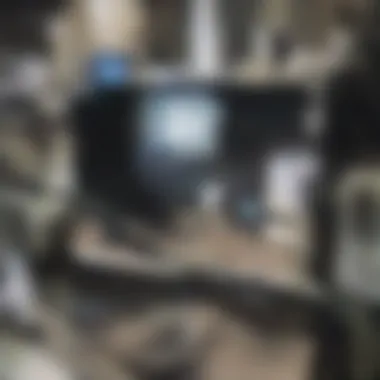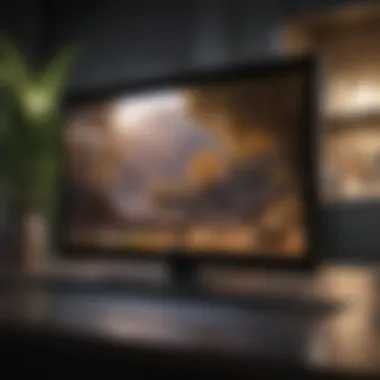Effective Techniques for Spotless TV Screens


Intro
Maintaining a clean TV screen is not just about aesthetics; it is essential for enhancing the viewing experience and prolonging the lifespan of your device. Over time, dust, fingerprints, and smudges may accumulate, affecting picture clarity and color accuracy. This article aims to provide a detailed guide on effective methods for cleaning your TV screen while addressing specific requirements based on screen types such as LCD, LED, and OLED.
Understanding Screen Types
Before diving into practical cleaning methods, it is important to understand the differences between the various types of screens. Each type has distinct properties that dictate the appropriate cleaning methods to employ.
- LCD (Liquid Crystal Display): These screens use liquid crystals sandwiched between layers of glass. They can be sensitive to certain cleaning agents, which may damage the screen.
- LED (Light Emitting Diode): Similar to LCD, LED screens use crystals but are backlit by LEDs. Care must be taken to avoid damage to the LED lights.
- OLED (Organic Light Emitting Diode): OLED screens offer superior color and contrast. They can be more susceptible to damage, requiring a cautious approach to cleaning.
Understanding these differences is vital in implementing the correct cleaning protocols.
Common Misconceptions About Cleaning TV Screens
Many individuals overlook the significance of proper cleaning techniques and materials. Common misconceptions include:
- Using paper towels: Many think paper towels are suitable for wiping screens. However, they can scratch the surface.
- Avoiding specialty cleaners: Some believe water alone suffices, but it may not effectively remove stubborn residues.
- Frequency of cleaning: Periodic cleaning is essential, but some underestimate the importance of routine care to maintain clarity.
A critical aspect of this guide is to dispel these myths and provide a clear understanding of effective screen maintenance.
The Importance of Using the Right Materials
Selecting the proper materials for cleaning is crucial. Here are some recommendations:
- Microfiber cloths: Soft, lint-free cloths are ideal for gently wiping screens without causing scratches.
- Screen cleaning solutions: Specialized cleaners, such as those made by Whoosh or Screen Mom, ensure a safe interaction with screen surfaces without harming the finish.
- Distilled water: If using a homemade solution, distilled water is preferable to avoid mineral deposits.
Utilizing the right cleaning materials significantly contributes to maintaining a pristine screen without adverse effects.
Step-by-Step Guidance on Cleaning Methods
The following steps can be adapted based on your specific screen type:
- Turn off the TV: This step helps in seeing the dust and smudges more clearly while ensuring safety.
- Choose your cleaning solution: Opt for a suitable commercial product or a mix of distilled water and white vinegar (1:1 ratio).
- Lightly dampen the cloth: Ensure that the cloth is not soaked to avoid drips that may enter the device.
- Wipe gently: Using circular motions, wipe the screen softly. Start from the top and move downward.
- Dry the screen: If necessary, use a dry part of the microfiber cloth to remove any streaks.
Using these methods will enhance both the cleanliness and longevity of your TV screen.
Preventive Measures for Long-Term Maintenance
Maintaining screen cleanliness goes beyond just cleaning. Implement preventive measures:
- Keep the area dust-free: Regularly dust the space around your TV to reduce accumulation on the screen.
- Limit direct sunlight: Position your TV away from direct sunlight to minimize glare and dust build-up.
- Use protective covers: When not in use, consider using a cover that protects from dust and environmental factors.
Understanding and appreciating the importance of these methods can significantly improve your TV’s visual performance. This article aims to empower readers with knowledge and best practices, supporting optimal care for their television screens.
Intro to TV Screen Maintenance
Caring for your television screen transcends mere aesthetics. It is a fundamental part of maintaining not just the appearance of your device, but also its performance and longevity. This section introduces the importance of TV screen maintenance and highlights critical elements that should be considered.
Understanding Screen Types
Different types of screens necessitate distinct cleaning approaches. Grasping these variations is vital for preserving the functioning of the screen.
Screens
LCD (Liquid Crystal Display) screens are prevalent due to their energy efficiency and slim profiles. A key characteristic is their ability to produce sharp images while consuming less power than traditional screens. One notable aspect of LCD screens is their sensitivity to scratches; thus, using proper cleaning materials is essential.
The benefits of LCD include bright colors and high resolution, making them a popular choice. However, they may suffer from glare in well-lit environments, which can diminish the viewing experience.
LED Screens
LED (Light Emitting Diode) screens represent a type of LCD technology but use LED backlighting. This enhances brightness and contrast, allowing for vibrant image quality. The smart design reduces energy consumption, making them an eco-friendly option.
The unique feature of LED screens lies in their longevity and energy efficiency. This makes them advantageous in both domestic and commercial settings, fostering a better viewing experience. However, they can sometimes be more expensive compared to conventional LCD screens.
OLED Screens


OLED (Organic Light Emitting Diode) screens produce astonishing contrast levels and deep blacks, owing to their self-lighting capability. This screen type is favored for its superior color accuracy and viewing angles.
A significant advantage of OLED technology is its thin profile and lightweight design. This allows for versatile installations in various environments. On the downside, their susceptibility to screen burn-in is a concern that users should acknowledge.
Recognizing the Need for Cleaning
Understanding when to clean the screen is crucial for maintaining your television.
Residue Accumulation
Over time, dust, fingerprints, and other residues accumulate on screens. This buildup can obscure image clarity, making regular cleaning essential. A notable aspect of residue accumulation is its tendency to affect the overall performance of the display.
The unique feature of this accumulation is that it often goes unnoticed until the screen appears significantly dirty. Regular cleaning can prevent long-term impacts on viewing quality and device lifespan.
Viewing Quality Impact
The clearness of your screen directly correlates to your viewing experience. Dust and streaks can detract from the sharpness and brilliance of the display, leading to a subpar experience. Key characteristics of viewing quality include contrast, brightness, and overall clarity of the image.
Addressing these quality impacts through routine cleaning not only elevates the viewing experience but also ensures that the screen performs at its best.
Regular maintenance is essential for providing the best viewing experience and prolonging the life of your television.
Effective cleaning methods can yield immediate improvements in image quality and overall satisfaction. Accepting the need for consistent screen upkeep can ultimately contribute to a vibrant viewing space.
The Importance of Using Appropriate Cleaning Materials
Using proper cleaning materials is essential for maintaining the integrity of your TV screen. Employing the right items not only ensures effective cleaning but also minimizes the risk of damage. Different screen technologies require distinct approaches, and using inappropriate materials can lead to scratches, streaks, or even permanent damage to the display. Thus, understanding which materials work best for your specific screen type is fundamentally important.
Microfiber Cloths
Benefits of Microfiber
Microfiber cloths are highly regarded for their effectiveness in cleaning delicate surfaces. They are made of fine synthetic fibers that are softer than cotton. One major benefit of microfiber is that it captures dust, dirt, and oils without scratching the screen. Additionally, they are reusable and can be washed multiple times without losing their cleaning power. This makes them an environmentally-friendly choice. They effectively absorb more liquid compared to traditional cloths, allowing for thorough cleaning without leaving lint behind.
How to Select Quality Cloths
When selecting microfiber cloths, it is crucial to consider quality. High-quality microfiber cloths often feature a dense weave and uniform texture. These characteristics ensure a more efficient cleaning experience. It is best to choose options that specifically state they are safe for electronics or screens. Some cloths come labeled as anti-static, which can be an added advantage as they won’t attract dust particles as easily.
Quality microfiber cloths can last a long time when cared for properly, thus providing good value. However, be aware that not all microfiber is created equal; some cheaper options may not work as well.
Cleaning Solutions
Store-Bought Cleaners
Store-bought cleaners can be convenient and effective if chosen wisely. Many brands design their cleaning solutions specifically for TV screens, ensuring they are safe for use. A key characteristic of these cleaners is their formulation, which usually avoids harsh chemicals that can damage delicate coatings on screens. This makes them a popular choice, particularly for those who prefer pre-formulated solutions.
When using these products, always check the labeling to confirm compatibility with your specific screen type. However, some store-bought cleaners can be more expensive than homemade alternatives, and they may also contain additives that some users prefer to avoid due to health concerns.
DIY Cleaning Solutions
DIY cleaning solutions offer a cost-effective alternative to store-bought products. Typically, these solutions involve simple ingredients like distilled water and vinegar or mild soap. The appeal lies in the ability to control what goes into the cleaning solution, catering to personal preferences for natural ingredients. This can reduce exposure to chemical additives found in many commercial cleaners.
However, the key to success with DIY solutions is dilution. Using excessively concentrated solutions can lead to streaks or residue on the screen. Thus, it is essential to maintain a proper ratio of water to any added ingredients. Overall, DIY options can provide a customized approach to cleaning while being budget-friendly.
Step-by-Step Cleaning Procedures
The process of cleaning your TV screen may appear simple, but certain procedures enhance the effectiveness while minimizing risk of damage. This section looks at the necessary steps to ensure your screen receives the proper care. Each part of the cleaning sequence plays a vital role, helping maintain both the functionality and aesthetics of your screen. Understanding these steps can improve your overall television experience, ensuring you enjoy clear visuals with every viewing session.
Preparing the Screen
Shutting Off the TV
Shutting off the TV is a critical initial step. By turning off the screen, you eliminate the strain on your eyes while cleaning. It’s also less likely for any residue or streaks to be magnified by the active display. This procedure provides a safer environment for cleaning as there is no electric current running through the TV, reducing risks of any accidental damage.
It is good practice to wait a few minutes after shutting off the TV. This allows the screen to cool down, which helps prevent potential heat damage due to the application of cleaning solutions.


Gathering Supplies
Gathering the right supplies is essential for effective cleaning. You will need a microfiber cloth, which is safe and efficient for delicate surfaces. This type of cloth is particularly beneficial because it does not scratch the screen and absorbs dust and oils well.
Select a cleaning solution that is recommended for your screen type. Not all cleaners are the same, and some contain chemicals that could harm your screen's finish. Having a designated container for cleaning solutions and cloths helps keep everything organized and ready for use.
Cleaning the Screen
Gentle Wiping Techniques
Employing gentle wiping techniques is vital to eliminate smudges without causing physical damage. The key here is to apply minimal pressure and use circular motions. This method ensures you cover larger areas without concentrating on one spot too long, which can lead to possible screen damage.
Using the right cloth is also part of this technique. A clean microfiber cloth, slightly dampened with the recommended cleaning solution, is optimal. Avoid rubbing abrasively, as this may lead to scratches or other issues.
Dealing with Stains and Smudges
In cases where there are persistent stains or smudges, a targeted approach is necessary. Identify the type of stain first, as some require specific treatment methods. Use a small amount of cleaner on a cloth and press gently on the stain, allowing it to absorb the solution without excessive rubbing.
Advantageously, most cleaning solutions for screens are formulated to dissolve oils and dirt effectively. This focused method allows for deep cleaning without risking the integrity of the screen. Always perform a spot test on an inconspicuous area first.
Final Touches
Drying the Screen
Drying the screen post-cleaning is an important final touch. Leaving moisture on the screen can lead to streaks or even potential internal damage if it seeps into the frame. Using a dry microfiber cloth, gently wipe the screen in a similar circular motion as before.
This step is especially critical after using liquid cleaners. Ensuring the screen is entirely dry contributes to the longevity of the device while also enhancing the viewing experience.
Checking for Remaining Marks
After drying, checking for remaining marks is essential. This can help you confirm whether the cleaning was successful or if additional cleaning is needed. Stand back and observe from different angles to see if any smudges remain.
The benefit of this check is it ensures your efforts resulted in a clear screen for optimal viewing. If marks persist, lightly repeat the cleaning process as needed, but always with care to avoid over-scrubbing or using too much liquid.
Remember, consistent maintenance leads to an enhanced viewing experience and better longevity for your TV.
Preventive Maintenance Strategies
Preventive maintenance strategies are essential in the context of maintaining the lifespan and quality of your TV screen. These methods focus on ensuring that the screen remains clean, functional, and free from damage. Engaging in regular upkeep can greatly enhance the viewing experience and keep the screen in optimal condition.
Regular Dusting
Regular dusting is one of the most straightforward yet effective strategies. This practice is fundamental to maintain a clear and vibrant display. Dust accumulation can obscure screen visibility and cause potential scratches over time.
Frequency Recommendations
The frequency of dusting largely depends on the TV's environment. For most households, cleaning the screen once a week can be advantageous, especially in dusty areas. This consistent approach helps mitigate buildup and keeps the TV looking its best. A key characteristic of this method is its simplicity, making it an easy habit to integrate. However, in homes with pets or significant outdoor activity, once every few days might be necessary. While this may seem excessive, the unique feature here is that it can further minimize the risk of dirt settling deeply into the screen's surface. The downside could be the time commitment but, overall, the benefits outweigh these concerns.
Methods to Dust Safely
When it comes to safe dusting, selecting the right materials is crucial. Using a microfiber cloth is recommended due to its softness and ability to trap dust without scratching the screen. The key characteristic of this method lies in its safety and effectiveness, appealing to anyone looking to preserve their screen's quality. The unique feature here is that microfiber materials won’t leave behind any lint or residue, enhancing overall cleanliness. However, when dusting, a gentle hand is necessary. Rubbing too forcefully can cause harm to the screen, making this approach beneficial yet requiring a cautious touch.
Optimal Viewing Conditions
Creating optimal viewing conditions is another important aspect of preventive maintenance. This strategy ensures that your viewing experience remains pleasant while minimizing strain on the eyes and screen.
Lighting Control
Managing lighting in the room is vital to improve both screen visibility and longevity. Avoid placing the TV in direct sunlight or brightly lit spaces, as glare can affect viewing quality. A beneficial aspect of this approach is that it also reduces the need for frequent cleaning caused by reflections. A unique feature of controlling lighting is that it fosters a more immersive viewing experience. However, balancing light can be tricky. Too much dimness can strain the eyes. It's essential to find the right balance to benefit fully from this strategy.
Screen Positioning
How you position your screen significantly impacts both its longevity and your viewing comfort. Placing the TV at eye level reduces neck strain, and also prevents the screen from being exposed to potential hazards. This method is advantageous because it includes both ergonomic benefits and protection from indirect damage. Moreover, positioning away from high-traffic areas diminishes the risk of accidental bumps.
Common Mistakes to Avoid


Cleaning a TV screen can seem straightforward, but it is easy to make mistakes that may lead to damaging the screen. Understanding common pitfalls is essential for maintaining the longevity and performance of your screen. Avoiding these errors ensures that your viewing experience remains optimal while prolonging the life of your display.
Using Incorrect Materials
Avoiding Paper Towels
One significant mistake is the use of paper towels. Although paper towels may seem like a convenient option for cleaning, they are abrasive and can scratch the screen. Their fiber structure is not designed for delicate surfaces, making them unsuitable for your TV. Instead, microfiber cloths are recommended because they are soft and non-abrasive. This feature allows for gentle cleaning that removes dust without causing damage. Moreover, microfiber can attract and hold onto dirt, providing a more effective clean than paper towels.
Refraining from Harsh Chemicals
Another critical aspect is to refrain from using harsh chemicals. Many conventional cleaners contain ammonia or alcohol, which can create a haze or even strip the protective coatings on modern screens. Instead, a gentle cleaning solution is preferable. DIY options, like a mixture of distilled water and vinegar, work effectively without risking harm. The unique feature of avoiding harsh chemicals lies in preserving the screen's clarity and integrity. This approach not only protects the physical structure but also keeps colors vibrant and reduces glare.
Improper Cleaning Techniques
Scrubbing Too Hard
When cleaning your TV, it is common to feel the need to apply more pressure to remove stubborn stains. However, scrubbing too hard can lead to significant damage, particularly on OLED screens which are prone to screen burn-in. A gentle touch accompanied by the right technique is essential for effective cleaning. Using slow, circular motions rather than abrasive scrubbing protects the screen while ensuring a thorough clean. This method also lessens the risk of push marks or inconsistencies in display quality.
Using Excessive Liquid
Lastly, using excessive liquid is a frequent error made during TV screen cleaning. Over-saturating the cloth can lead to liquid seeping into the edges of the screen, potentially resulting in internal damage that may not be repairable. For safety, it’s best to dampen the cloth instead of applying liquid directly to the screen. This method allows you to maintain control over the amount of moisture applied, preserving the screen's condition.
Using the proper materials and techniques is crucial for maintaining your TV's performance and longevity.
Understanding Screen Longevity
Screen longevity refers to the lifespan and overall health of your television's display. Understanding this concept is crucial for maintaining the quality and functionality of your screen over time. Regular cleaning and proper care have significant roles in keeping your screen looking new and functioning well.
Moreover, recognizing the elements that contribute to screen longevity can help prevent costly repairs or replacements down the line. Through proper maintenance routines, you can improve viewing experiences and extend the overall life of your television.
Effects of Regular Cleaning
Enhanced Viewing Experience
The enhanced viewing experience is one of the most immediate benefits of regular cleaning. Clean screens provide clearer images and richer colors. When dust and smudges accumulate on a screen, they obstruct the light that passes through. This can result in dull colors and reduced contrast, diminishing the overall picture quality. Regular cleaning ensures that the screen is free from these obstructions, providing an optimal viewing environment.
Additionally, a clean screen may help in reducing glare, allowing viewers to enjoy their content without distractions. This is an important consideration for those often exposed to various lighting conditions in their homes.
Improved Screen Lifespan
Improved screen lifespan results from consistently caring for your screen. Over time, accumulated dust and dirt can cause wear and tear. Regular cleaning helps to mitigate this risk, allowing the screen to operate effectively for a longer period. A significant aspect to note is that many screens, particularly LED and OLED types, can develop issues due to neglect. For instance, dust buildup may lead to overheating.
Cleaning your TV screen can keep it functioning at optimal levels, extending its useful life. This is a desirable outcome for many users, as it saves money on potential repairs or replacement devices.
Signs of Damage to Watch For
Being aware of potential damage is just as critical as maintaining your screen’s cleanliness. Certain indicators signal that your television may need professional attention.
Screen Burn-In
Screen burn-in occurs when static images persist on the screen, creating permanent ghost images. This is especially common in OLED screens, where consistent display of logos or menu items can cause uneven aging of pixels. Recognizing burn-in early can safeguard against further degradation and significantly contributes to overall screen longevity. Preventive measures, like varying your content and using screen savers, can reduce the risk of burn-in, making it an important consideration for television users.
Pixel Damage
Pixel damage manifests as dead or stuck pixels. These can appear as small dots on your screen, often noticeable against solid backgrounds. Stuck pixels may display the same color continually, while dead pixels remain dark. Typically, pixel damage indicates that the screen is nearing the end of its lifespan or has suffered physical harm. Understanding these signs can prompt users to act promptly, whether it be to address minor issues or to reconsider the longevity of their current display.
Regular evaluation of your screen and awareness of these damages can lead to proactive care, ultimately promoting overall screen wellness and performance.
Epilogue and Final Thoughts
In summary, maintaining a clean TV screen is essential for achieving an optimal viewing experience. As the focus of this article has shown, each screen type—LCD, LED, or OLED—requires specific care methods to avoid damage while ensuring the best picture quality. Adhering to best practices in cleaning can significantly enhance the longevity of your display, contributing not only to clearer visuals but also to a better overall enjoyment of the media consumed.
Summary of Best Practices
- Use Appropriate Cleaning Materials: Always opt for microfiber cloths to avoid scratches and lint on your screen. Harsh chemicals and paper towels are best avoided to prevent damage.
- Implement a Regular Cleaning Schedule: Cleaning your screen regularly can prevent build-up of dust and fingerprints, making the process easier and safer.
- Apply Gentle Techniques: Lightly wipe the screen in a circular motion, applying minimal pressure to avoid damage.
- Monitor Environment: Keep your TV in a well-lit area to reduce glare, and position it away from direct sunlight to minimize the dust.
Encouraging a Cleaning Routine
Establishing a cleaning routine is not just about keeping your TV screen pristine; it extends the life of the unit. Setting a specific day each month for maintenance can help integrate it into your lifestyle. This proactive approach will also alleviate any potential surprises, such as unclear images or sudden damage. Encourage members of your household to participate; a shared responsibility can foster a collective appreciation for your living space.
Remember, a clean screen not only looks better but contributes significantly to an enhanced visual experience. Regular maintenance ensures that your investment in home entertainment is well protected. By following the guidelines provided in this article, you can confidently care for your screen.
"A clean screen is a portal to clearer entertainment—embrace routine maintenance for lasting enjoyment."







